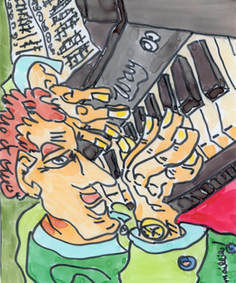|
Before we answer that question, let's make some assumptions:
 Now, in order to continue being an artist, you might just want to cover the cost of materials and you'd be happy with that. Maybe you'd like to make a little more, pay for a vacation, something extra. Or, you could want to quit your day job altogether. In any case, you need to sell something, so now you have a business. And, as is the case for any sort of business, you don't just need to get the word out about what you do, you need to differentiate yourself from the competition.  Myles Maillie Myles Maillie How does an artist define competition? That's easy: the same way any other business does. Competition is anything that can replace what you have to sell. Read that last sentence again. In the case of art, which is mostly a completely optional purchase, just about anything can replace it. People don't have to buy art: they do have to buy food and transportation and housing and health care and a ton of other things. Your competition isn't just other artists. How does a potential art buyer find you? They shop, just like they do for shoes or jewelry or just about anything else. Let's assume you have already figured out the best places to sell your art, like galleries, shows, website, social media, licensing, patronage, etc. Are you the only artist in any of these sales venues? No. So why should a potential art buyer purchase your art when there are so many choices? Branding. (And and that means a lot more than just a logo.) But, isn't branding just for consumer goods? To artists, art is sacred, our life's work. When a buyer says "That matches my sofa. I'll take it," we die inside just a little. But we swipe the card and live to create another day. Art isn't a box of cereal, or a pair of sneakers, but companies who make those things have figured out that branding works. They know how to differentiate themselves from the other choices out there. Branding doesn't have to be slick. It just has to promise something. Know the artist Banksy? His (or her) brand is mystery. The art appears, and people want to know who did it. Thomas Kincaide's brand is a sort of pretty idealism. What does your art do for your potential buyer? What does it promise, and how is that different from the artist next to you in the gallery or at the show? Online, how do you stand out in a Google search, if your website is found at all? Your name alone isn't enough. Unless your name is Picasso, or you already have a large following (in which case, you stopped reading already), your name alone probably doesn't send enough of a message to potential buyers. And a brand isn't just a logo, it's everything to do with the business. Here are some ways you can differentiate your brand from that of other artists. 1. Your art is truly unique and stands on its own. Myles Maillie developed a style unto itself and has been known for it for decades. If you also create art that is like no other, that's your brand. If you paint beach scenes or make pottery, it may take something a bit more to craft a brand. 2. Your artistic persona is intriguing. Artist Cory Basil could easily fall into the category above, but at least as interesting as his art is his personal style. Dark, brooding, sort of The-American-West-meets-steampunk? Hard to categorize, which is exactly the point. 3. Your art business (or studio) has a cool name. Kristina Young named her art business The Art of Peace. Her brand is all about personal growth and enlightenment and will appeal to people with the same interests. Once you know what your brand should be, the next move is to nail down a domain name immediately. Even if you aren't quite ready to put up a website, get the name you want before someone else does. More about marketing your art online in a future post. Keep creating, and be thinking about your brand. CONTACT US
Kim Phillips is an artist, marketer, writer, graphic designer and gardener living in Cowan, Tennessee. She works from her studio, Tiny Creative House. © 2018 Kim Phillips | Tiny Creative House
0 Comments
Leave a Reply. |
Kim PhillipsFinding a balance between art, commerce, and a natural life. Archives
April 2020
Categories |
